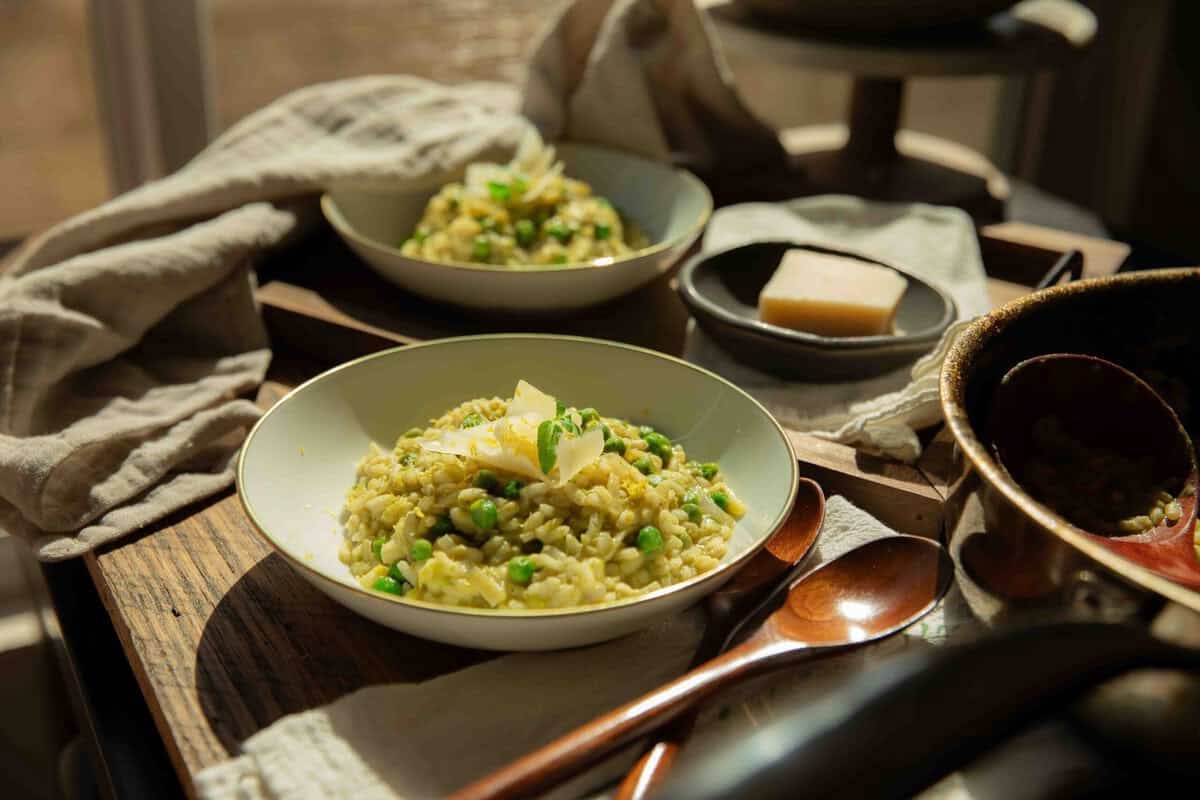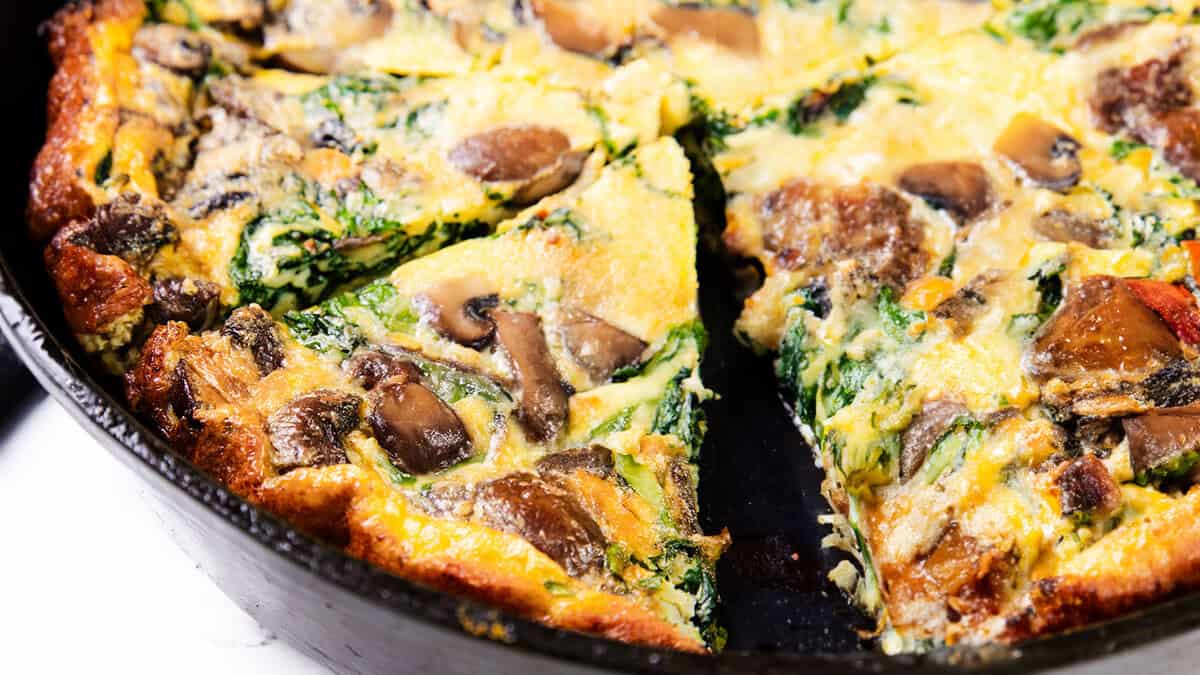
Easy.
Springy.
GREEN.
These three words perfectly describe this sweet green pea risotto recipe, which is honestly the perfect dinner any night of the week. While it takes some patience (not gonna lie) to achieve the famously luxurious texture and creamy consistency, there aren’t a lot of steps in this spring pea risotto recipe. Whether this is your first time making a risotto recipe or you’ve been making risotto on a weekly basis since you were 9 years old (lucky you), consider this a reminder on the NEED to add sweet peas into your life!
So, whether you’re making ideal spring meal tonight or meal prepping for the next few days (trust–it tastes GREAT the next day!), let’s get into it!
Disclaimer: Some of the links in this post may be affiliate links for products I use and love. If you make a purchase after clicking one of those links, I may earn a small affiliate commission, perhaps enough to buy some extra gochujang or gochugaru 🙂
What Even Is Risotto?
I always like to start with the basics when it comes to cooking–especially when cooking culturally significant dishes like Italian recipes. So, let’s start with the fundamentals. What does “risotto” literally mean in Italian?
Risotto is a combination of the word “riso,” which means “rice,” and the suffix “-otto,” which typically indicates something diminutive OR a distinct style to the base word. “Risotto” thus refers to a specific or traditional preparation of rice.
What is that traditional cooking process for risotto? At its core, risotto is rice cooked in broth, kind of like “juk” in Korean. And like Korean style juk, the rice in risotto is stirred constantly to facilitate the release of starch, which, in turn, creates the best texture for your risotto. But unlike congee or Korean rice porridge, the rice is served al dente. If you can’t tell, by now, risotto is about texture, not flavor. Though, I can guarantee you: this green pea risotto has the BEST FLAVOR EVAR!
Why You’ll Love this Green Pea Risotto Recipe.
This simple recipe for green pea risotto is going to among your favorites because it’s:
- CREAMY
- FLAVORFUL
- FOOLPROOF
Look, I know that Gordon Ramsey has essentially scared us into thinking that cooking risotto–particularly green risotto (his specialty)–is the most infernally difficult thing in the whole world. But this simple recipe for green pea risotto is going to prove him wrong. YOU CAN and WILL achieve a restaurant worthy creamy risotto after trying this recipe. I promise! We’ll go step-by-step (as always), so you know what to look out for and what to avoid.
Key Ingredients and Notes on Substitutions for Green Pea Risotto Recipe.
I’m Korean. I love rice. Every kind of rice. So, as we take a look at the key ingredients and discussion substitutions for this green pea risotto recipe, let’s start with RICE!
Rice.
Ok. Everyone knows that you MUST use arborio rice and only arborio rice for good risotto.
WRONG!!
Arborio rice is ideal for risotto, because it is a short-grain rice with a lot of starch content; but, it isn’t the only rice you can use for risotto, including this green pea risotto. In fact, it isn’t even the best rice for risotto! That honor belongs to carnaroli–often dubbed the “king of risotto rice.” Why? Because it has an even higher starch content than arborio. Let’s take a look at the rice varieties for the best, not bad, and not good risotto:
The Best Rices for Risotto.
- Carnaroli (highest starch content, holds shape well even when overcooked, great for beginners looking for the best results)
- Arborio (high starch content, easy to find at most grocery stores)
- Vialone Nano (provides a super creamy texture, ideal for vegetable risottos like this one)
Rices You Can Use If You Can’t Get The Above.
- Sushi Rice (pretty decent starch content, but will get sticky more than creamy)
- Calrose Rice (easily accessible in western grocery stores, less starchy but not bad)
- Short-Grain Brown Rice (chewier and healthier, but will not get very creamy and requires a lot longer time to prepare)
Rices You Should NOT Use To Make Risotto.
- Basmati or Jasmine Rice (far too long and has a very low starch content, won’t get creamy)
- Parboiled or Instant Rice (the starches won’t release correctly and your rice will fall apart)
- Wild Rice or Black Rice (again, too long and not enough starch content)
Green Peas.
Yes, believe it or not, this green pea risotto recipe requires green peas! As you can see from the photos, I lucked into a bevy of fresh peas at my local farmers market. But, have no fear! This lush risotto recipe tastes fantastic with both fresh spring peas and frozen peas alike. Just make sure you opt for frozen sweet green peas if you’re going to go with that option, in order to optimize the sweet flavor for this green pea risotto recipe!
Shallots & Garlic.
Shallots play a very important role in amping up the umami of this green pea risotto, but not overpowering the flavor of the peas. If you want, you can substitute in regular onions, though onions, in my opinion, tend to be a little harsh, if you will, when compared to shallots. I did include a little garlic in this recipe, but, I’m told that in Northern Italy (which is the region where risotto was born!), most home cooks avoid garlic, because it’s seen as too much flavor (this is something I’ve hard about garlic more than once from a native Italian, believe it or not!).
Dairy-free Plain Yogurt.
The key to creating pea-perfect flavor for this green pea risotto is to give the peas a platform. Wait, whut? Imagine we’re all at a big party, mostly filled with rice. You’re a grain of rice, I’m a grain of rice, we’re all grains of rice. But this isn’t just a rice party. It’s a rice party themed around the star–the green pea. In order to make sure the star is seen, though, amid a mass of swirling rice grains, we need to create some… scaffolding. Enter flavor agents: plain yogurt, fresh herbs, and lemon zest.
These flavor agents, when used appropriately, will create the burst of freshness and the bright flavors that will ensure the peas are truly the star of this green pea risotto. It will also hedge your bets when it comes to achieving that perfectly dreamy, creamy texture (it’s not really cheating if the main purpose is to amp up pea-flavor…). If you don’t have vegan yogurt, you can use vegan sour cream or vegan cream cheese (I prefer Tofutti for both). You can also use vegan heavy cream.
Fresh Mint.
As I explained above, the peas will really come to life in this green pea risotto dish if you give them some help. Fresh mint, fresh parsley, fresh basil–they’ll all help to do this, because of their naturally bright flavor profiles. And don’t worry–you won’t be adding a lot, just a little to amp things up for our peas. I used fresh mint for this recipe and it tasted AMAZING. But if you don’t have fresh mint, like I said, you can use fresh parsley or basil. I would avoid some of the earthier herbs (e.g., sage) to keep this risotto springy!
Vegan Parmesan Cheese.
The vegan parmesan cheese in this green pea risotto recipe provides that sharp, saltiness that will help accentuate the green flavors from the peas. My preferred vegan parmesan is Violife. If you don’t have access to a brick of vegan parmesan, you can grate whatever vegan cheese you have on hand. If you don’t like vegan cheese, you can also substitute nutritional yeast.
Vegan Butter.
I use vegan butter for this green pea risotto recipe, only because the fat from the vegan butter helps with creating a thicker, richer, creamier risotto. But if you don’t have or like vegan butter, you can absolutely substitute with extra virgin olive oil (which is what my Italian cousin likes to use for his risotto–he’s Roman!).
Dry White Wine.
Why do people use wine for risotto? Well, wine does a couple of uniquely important things for this rice dish. First, it provides a touch of acidity to what is otherwise a pretty rich dish. It helps to cut through the butter, olive oil, and cheese. Second, the wine helps to enhance the deep aromatics of the garlic and shallots. Finally, the wine also leaves behind a sweet note that pairs well with the sweet green peas.
What kind of wine? You should go for a dry white wine for this green pea risotto, like a Pinot Grigio or Sauvignon Blanc. If you don’t have any wine around or prefer not to use it, you can always substitute with vegetable broth.
Vegetable Broth.

In order to cook your rice for your green pea risotto, we need a liquid and that liquid is vegetable broth. I use my favorite store bought brand (Pacific), but feel free tot use a homemade vegetable stock! I recommend using a low sodium vegetable broth, so that you can control the saltiness. Can you use water? Yes, in a pinch, you can use water. But you will lose out on a little flavor for your rice, and you may end up needing to add a touch more salt.
Step-by-Step Instructions for Making Green Pea Risotto Recipe.
Step 1. Make the Pea Purée.
If you are using fresh peas, clean them and place them in a pot of boiling water. Cook until they turn a vibrant green (about 2 to 3 minutes). Drain and rinse under cold water. If you are using frozen peas, reheat them according to package instructions. Then, add 1 cup of the cooked peas to a large measuring cup or tall container, together with 1 tablespoon of extra virgin olive oil, 2 tablespoons of vegan parmesan, 2 teaspoons of lemon zest, 3 small mint leaves, 1/4 cup vegan yogurt, and 1/2 cup water. Set this aside.
Step 2.
One one burner, place a small pot containing all the vegetable broth over low heat. On a second burner, add 1 tablespoon of extra virgin olive oil and butter to a large skillet over medium-high heat. When it’s pretty much fully melted, add shallots, garlic, and salt. Sauté until the shallots become transparent (around 3 minutes). Add rice and stir well until the grains are evenly coated. Continue stirring regularly for about 3 minutes, until the rice grains begin to toast and turn slightly brown. Deglaze the pan with the wine, stirring the rice and veggies so they are evenly coated. Cook until the wine has cooked off (around 1 minute). Reduce heat to low.
Step 3.
Add two ladlefuls of the hot broth, stirring it into the rice. Continue stirring not continuously but regularly until most of the broth has evaporated (around 5 minutes). Then, pour in 1/3 of the pea purée and incorporate into the rice, together with 1 ladle of broth. Cook, while stirring regularly, until the liquid has nearly evaporated (around 5 minutes). Repeat. You should have 1/3 of the pea purée left. Set this aside (you’re saving this for the end). Continue ladling hot broth into the rice, stirring regularly to release the rice starch, until all the broth is used up and your rice grains are tender on the outside, but retaining bite at their center (al dente). Turn off heat.
Step 4.
Add the remaining peas, pea purée, and 2 more tablespoons of grated vegan parmesan cheese. Incorporate into rice and continue stirring for about 30 seconds before serving. Garnish with a drizzle of olive oil, more cheese, fresh cracked pepper, and tiny mint leaves.
Do’s and Don’ts of risotto.
DO use a rice with a high starch content, like carnaroli rice or arborio rice.
DO NOT use a low starch content rice, like jasmine or basmati rice; parboiled or microwavable rice; or wild or black rice.
DO make sure to toast your rice before you add any broth to your risotto.
DO NOT put the lid on–EVAR!!–while cooking your risotto, as this will steam your rice.
DO stir your rice frequently while it cooks in the broth, as this will release the starches in the rice.
DO NOT stand over your rice stirring non-stop, as this will ensure your nice never cooks.
DO season your risotto with salt per your taste.
DO NOT use salted butter or full sodium vegetable broth, so you can control the saltiness.
DO use hot broth to cook your risotto.
DO NOT use cold broth or cold water, as this will make your rice mushy.
DO keep your heat on low as you cook and stir your risotto, as this will promote the release of starches.
DO NOT try and speed up your cook time by raising the heat, as this will likely scorch your risotto and uneven absorption of broth.
DO cook your risotto until your rice is tender on the outside, but chewy in the center.
DO NOT cook your risotto until your rice is mushy or falling apart.
DO cook your risotto until most of the liquid is gone and the risotto spreads gently on your plate or bowl.
DO NOT cook your risotto until there isn’t a drop of liquid left and your rice is bone dry!
Frequently Asked Questions.
Is risotto naturally gluten free?
Yes! Most risotto recipes, including this green pea risotto recipe, are gluten free!
Can I use frozen peas for this recipe?
Absolutely. You can swap in frozen peas for this green pea risotto recipe.
What’s a good substitute for vegan yogurt?
Vegan sour cream and vegan cream cheese are all good substitutes for vegan yogurt in this green pea risotto recipe.
How can I store the leftovers?
Place any leftovers in an airtight container. Store in the refrigerator for up to 5 days. To reheat, simply microwave.
Want More Pasta Recipes?
I got you. Check out the following:
Recipe Card.
Sweet Green Pea Risotto.
Joanne Molinaro
The perfect spring risotto recipe when you want to get fancy!
Prep Time 15 minutes
Cook Time 25 minutes
Course Main Course
Cuisine Italian
Servings 4
Calories 406 kcal
Pea Purée.
- ▢ 1 cup green peas
- ▢ 1 tbsp extra virgin olive oil
- ▢ 2 tbsp vegan parmesan cheese
- ▢ 1/4 cup vegan yogurt
- ▢ 1/2 tsp black pepper
- ▢ 2 tsp lemon zest
- ▢ 3 mint leaves
- ▢ 1/2 cup water
Risotto.
- ▢ 1 tbsp extra virgin olive oil
- ▢ 2 tbsp vegan butter
- ▢ 1 shallot (julienned)
- ▢ 2 cloves garlic (minced)
- ▢ 1 tsp sea salt
- ▢ 1 cup risotto rice (see Key Ingredients section for rice varieties)
- ▢ 1/4 cup dry white wine
- ▢ 4 cups vegetable broth
- ▢ 2 tbsp vegan parmesan cheese
If you are using fresh peas, clean them and place them in a pot of boiling water. Cook until they turn a vibrant green (about 2 to 3 minutes). Drain and rinse under cold water. If you are using frozen peas, reheat them according to package instructions.
Add 1 cup of the cooked peas to a large measuring cup or tall container, together with 1 tablespoon of extra virgin olive oil, 2 tablespoons of vegan parmesan, 2 teaspoons of lemon zest, 3 small mint leaves, 1/4 cup vegan yogurt, and 1/2 cup water. Using an immersion blender, blend until roughly smooth. Set this aside.
One on burner, place a small pot containing all the vegetable broth over low heat. On a second burner, add 1 tablespoon of extra virgin olive oil and butter to a large skillet over medium-high heat. When it's pretty much fully melted, add shallots, garlic, and salt. Sauté until the shallots transparent (around 3 minutes). Add rice and stir well until the grains are evenly coated with the oil and butter. Continue stirring regularly for about 3 minutes, until the rice grains begin to toast and turn slightly brown. Deglaze the pan with the wine, stirring the rice and veggies so they are evenly coated. Cook until the wine has cooked off (around 1 minute). Reduce heat to low.
Add two ladlefuls of the hot broth, stirring it into the rice. Continue stirring not continuously but regularly until most of the broth has evaporated (around 5 minutes). Then, pour in 1/3 of the pea purée and incorporate into the rice, together with 1 ladle of broth. Cook, while stirring regularly, until the liquid has nearly evaporated (around 5 minutes). Repeat. You should have 1/3 of the pea purée left. Set this aside (you're saving this for the end). Continue ladling hot broth into the rice, stirring regularly to release the rice starch, until all the broth is used up and your rice grains are tender on the outside, but retaining bite at their center (al dente). Turn off heat.
Add the remaining peas, pea purée, and 2 more tablespoons of grated vegan parmesan cheese. Incorporate into rice and continue stirring for about 30 seconds before serving. Garnish with a drizzle of olive oil, more cheese, fresh cracked pepper, lemon zest, and tiny mint leaves.
- Always check out the Key Ingredients and Substitutions section for a discussion on picking out the best rice, as well as potential substitutions.
- DO NOT put the lid on–EVAR!!–while cooking your risotto, as this will steam your rice.
- Stir your rice frequently while it cooks in the broth, as this will release the starches in the rice. However, do not stand over your rice stirring non-stop, as your rice will never cook completely if you do this.
- Avoid using salted butter or full sodium vegetable broth. Season your risotto with salt, to taste.
- Keep your heat on low once you start cooking your rice in the broth. Do NOT try and speed up the cooking time by increasing the heat–this will end up scorching your rice and cause uneven absorption of the broth.
- Cook your rice until it is tender on the outside but still a little chewy in the center (al dente).
- Your risotto should have a little liquid left in it at the end, so that when it pours out onto your plate, it spreads like a wave.
Calories: 406kcalCarbohydrates: 55gProtein: 10gFat: 15gSaturated Fat: 4gPolyunsaturated Fat: 2gMonounsaturated Fat: 7gTrans Fat: 0.03gSodium: 1705mgPotassium: 198mgFiber: 4gSugar: 6gVitamin A: 1079IUVitamin C: 17mgCalcium: 53mgIron: 4mg
Note: Nutritional information is provided for your convenience. It should only be considered an estimate that can vary greatly depending on a multitude of factors (e.g. additions, subtractions, amount and type of oil used, etc.)
Keyword green pea risotto
Did you like this recipe? If so, please leave a rating and share it!














![I can eat this every day❗️SIMPLE Tofu & Eggs Soup [Korean Soft Tofu Stew; Soondubu Jjigae] 순두부 계란찌개](https://i.ytimg.com/vi/dhboYx9rfRQ/maxresdefault.jpg)






 English (US) ·
English (US) ·